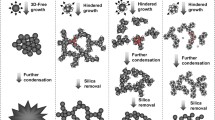Abstract
A solvothermal method is described for preparing nanomaterials of titanium oxide with different morphologies. Nanostructures, such as wire, rod, cube, and fiber, were synthesized in mass quantities by controlling either the concentrations of the precursor or growth temperature and introducing different additives in one simple system based on titanium tetroisopropoxide and ethylene glycol. Hydrothermal treatment of the base system produced nanowires with diameters around 40 nm. The addition of ethylenediamine (EDA) to the system inhibited the radial expansion of the nanowires, resulting in nanorods and nanofibers with diameters down to about 2 nm. Increasing the EDA concentration tended to induce mesoscale self-assembly of nanofibers into arrays. The presence of water promoted the formation of nearly spherical nanoparticles with sizes dependent on the EDA concentration. At higher temperatures, the same system yielded well-defined nanobelts or nanocubes. The replacement of EDA by 2,4-pentanedione favored the formation of nanosheets while tetramethylammonium hydroxide appeared to confuse the growth of nanorods, creating a continuous network.





Similar content being viewed by others
References
Hadjiivanov KI, Klissurski DG (1996) Chem Soc Rev 25:61
Anpo M, Takeuchi M (2003) J Catal 216:505
Fujishima A, Rao TN, Tryk DA (2000) J Photochem Photobio C: Photochem Rev 1:1
Kaneko M, Okura I (2002) In: Photocatalysis science and technology, Kodansha, Springer
Bach U, Lupo D, Comte P, Moser JE, Weissortel F, Salbeck J, Spreitzer H, Gratzel M (1998) Nature 395:583
Gratzel M (2001) Nature 414:338
Zhang D, Yoshida T, Furuta K, Minoura H (2004) J Photochem Photobio A: Chem 164:159
Akikusa J, Khan SUM (2002) Int J Hydrogen Energy 27:863
Fujihara K, Ohno T, Matsumura M (1998) J Chem Soc, Faraday Trans 94:3705
Meier K, Gratzel M (2002) Chemphyschem 4:371
Paunesku T, Rajh T, Wiederrecht G, Master J, Vogt S, Stojicevic N, Protic M, Lai B, Oryhon J, Thurnauer M, Woloschak G (2003) Nat Mater 2:343
Cozzoli PD, Kornowski A, Weller H (2003) J Am Chem Soc 125:14539
Huynh WU, Dittmer JJ, Alivisatos AP (2002) Science 295:2427
Li J, Wang LW (2003) Nano Lett 3:1357
Lei Y, Zhang LD, Meng GW, Li GH, Zhang XY, Liang CH, Chen W, Wang SX (2001) Appl Phys Lett 78:1125
Zhang Q, Gao L (2003) Langmuir 19:967
Sugimoto T, Zhou X, Muramatsu A (2003) J Colloid Interface Sci 259:53
Sugimoto T (2003) Chem Eng Technol 26:313
Chemseddine A, Moritz T (1999) Eur Inorg Chem 1999:235
Trentler TJ, Denler TE, Bertone JF, Agrawal A, Colvin VL (1999) J Am Chem Soc 121:1613
Armstrong AR, Armstrong G, Canales J, Bruce PG (2004) Angew Chem Int Ed 43:2286
Jun Y, Casula MF, Sim JH, Kim SY, Cheon J, Alivisatos AP (2003) J Am Chem Soc 125:15981
Fieevet F, Lagier JP, Figlarz M (1989) MRS Bull 14:29
Sun Y, Xia Y (2002) Adv Mater 14:833
Wang Y, Jiang X, Xia Y (2003) J Am Chem Soc 125:16176
Jiang X, Wang Y, Herricks T, Xia Y (2004) J Mater Chem 14:695
Wang Y, Jiang X, Herricks T, Xia Y (2004) J Phys Chem B 108:8631
Jana NR (2004) Angew Chem 116:1562
Acknowledgements
This study was supported by the Center of Advanced Materials for the Purification of Water with Systems, National Science Foundation, under Agreement Number CTS-0120978 and by the National Basic Research Program of China through Grant No. 2006CB601201. Characterization was carried out in CMM and LSF centers at the Frederick Seitz Materials Research Laboratory, University of Illinois at Urbana-Champaign, which is partially supported by the U.S. Department of Energy under grant DEFG02-91-ER45439.
Author information
Authors and Affiliations
Corresponding author
Additional information
Rong-Cai Xie—Formerly with the University of Illinois at Urbana-Champaign.
Rights and permissions
About this article
Cite this article
Xie, RC., Shang, J.K. Morphological control in solvothermal synthesis of titanium oxide. J Mater Sci 42, 6583–6589 (2007). https://doi.org/10.1007/s10853-007-1506-0
Received:
Accepted:
Published:
Issue Date:
DOI: https://doi.org/10.1007/s10853-007-1506-0




